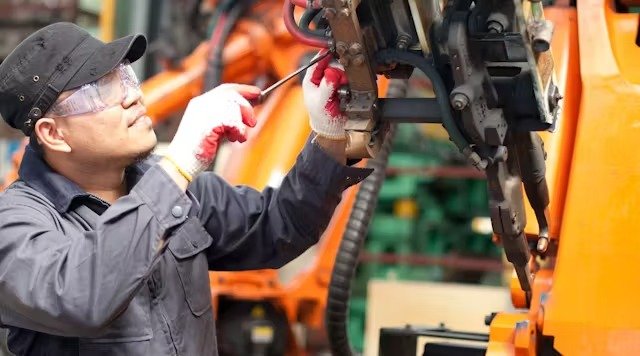Large industrial equipment is the foundation of many heavy industries, from construction to manufacturing and mining. These massive machines handle critical operations that keep industries running, making their maintenance a top priority. Proper upkeep not only extends the life of these expensive assets but also ensures safety, minimizes downtime, and boosts productivity.
The Importance of Maintaining Large Equipment
Investing in large industrial machinery is a significant capital expense for any business. Neglecting regular maintenance can lead to serious consequences, including unexpected breakdowns, safety hazards, and higher operating costs. Here’s why maintenance should always be a priority:
- Operational Efficiency: Well-maintained equipment operates smoothly, reducing the likelihood of interruptions that can halt production.
- Safety Benefits: Proper maintenance ensures all machinery operates within its safety parameters, protecting workers from potential accidents.
- Cost Savings: Repairs from unexpected failures are often more expensive than regular preventive maintenance. Additionally, downtime caused by breakdowns affects overall profitability.
- Extended Equipment Life: Routine care protects machinery from wear and tear, maximizing its lifespan and ensuring you get the best return on investment.
For industrial operations that depend on specialized machinery, maintenance is not an option—it’s a necessity.
Strategies for Effective Maintenance
Every industrial machine requires a tailored maintenance plan suited to its specific function, workload, and operating environment. Implementing structured strategies is essential to ensure equipment is always in peak condition. Here are some proven approaches:
1. Establish a Maintenance Schedule
Following a consistent maintenance schedule is critical to catching small issues before they develop into larger problems. Planned inspections allow operators and technicians to replace worn parts, lubricate critical components, and monitor equipment performance.
- Daily Maintenance Checks: Identify issues by inspecting equipment at the start or end of every shift. Pay close attention to fluid levels, visible damage, and loose connections.
- Periodic Deep Inspections: Perform thorough examinations monthly or quarterly to assess internal components such as hydraulic systems, filters, and structural supports.
A solid schedule ensures no maintenance task is overlooked, no matter how trivial it may seem.
2. Train Equipment Operators
Equipment operators are the first line of defense against mechanical failures. Providing them with comprehensive training helps minimize the risk of improper use, which is a leading cause of wear and tear.
- Teach Proper Operation Techniques: Operators should understand optimal machine settings for different tasks and avoid overloading capacity.
- Encourage Reporting Issues: Workers should be trained to spot irregularities, such as strange sounds, vibrations, or leaks, and report them immediately.
- Provide Refresher Courses: Offer periodic training to keep operators updated on the latest maintenance techniques and safety protocols.
Skilled operators act as an additional layer of protection, identifying and addressing potential issues early on.
3. Implement Preventive Maintenance
Preventive maintenance focuses on fixing potential problems before they escalate. This proactive approach keeps machines running reliably while reducing the frequency of major repairs.
- Inspect Vital Components Regularly: Focus on frequently used parts like bearings, belts, and hoses that tend to wear out faster.
- Lubricate Moving Parts: Proper lubrication minimizes friction, reduces heat buildup, and prevents premature wear.
- Analyze Wear Trends: Use data from past inspections to recognize recurring issues and address them proactively.
By maintaining functional parts and replacing worn components ahead of time, preventive measures can prevent costly setbacks.
4. Utilize Advanced Monitoring Systems
Modern technology plays a significant role in improving maintenance practices. Advanced monitoring systems provide real-time insights into equipment performance, helping technicians make data-driven decisions.
- Install Sensors: Vibration, temperature, and pressure sensors can detect irregularities and send alerts before a failure occurs.
- Track Equipment Usage: Digitally monitor wear metrics such as operating hours, load capacity, and idle time to schedule maintenance more accurately.
- Centralize Data Analysis: Use software to consolidate performance data, making it easier to identify trends and predict potential issues.
These systems enhance reliability by ensuring equipment operates within optimal parameters at all times.
Essential Tools for Maintenance
Keeping heavy machinery in top condition requires specialized tools designed for industrial-scale tasks. Using the right equipment improves efficiency and minimizes the risk of damage during maintenance. Essential tools include:
- Hydraulic Jacks: These are crucial for lifting large machines during inspections or repairs.
- Alignment Equipment: Ensuring proper alignment of rotating components helps prevent unnecessary wear and tear.
- Mobile Toolkits: Comprehensive toolkits that include wrenches, diagnostic devices, and lubricants allow technicians to address issues on-site.
- Field Machining Equipment: When repairing large machinery onsite, portable machining tools enable accurate cutting, milling, or drilling without transporting the equipment to a workshop.
Access to these tools ensures technicians can carry out maintenance tasks safely and with precision, supporting uninterrupted operations.
The Role of Record Keeping in Maintenance
Documentation is an often-overlooked aspect of effective equipment maintenance. Maintaining accurate records of past inspections, repairs, and replacement parts offers several benefits:
- Streamlined Scheduling: Records help technicians plan upcoming maintenance tasks based on historical data.
- Detailed Equipment History: Logs provide insight into recurring issues, enabling better sourcing of parts and solutions.
- Compliance Assurance: Many industries have regulations requiring detailed maintenance records to ensure worker and workplace safety.
Regular updates to maintenance logs improve accountability and optimize decision-making for long-term equipment care.
Maintaining large industrial equipment is the backbone of heavy industry, playing a critical role in ensuring safety, efficiency, and cost savings. From creating structured maintenance schedules to incorporating modern tools like field machining equipment, every aspect of upkeep contributes to prolonged machinery lifespans and smoother operations. By implementing these best practices, businesses can prioritize the reliability and durability of their essential machines, securing both short-term productivity and long-term success.









